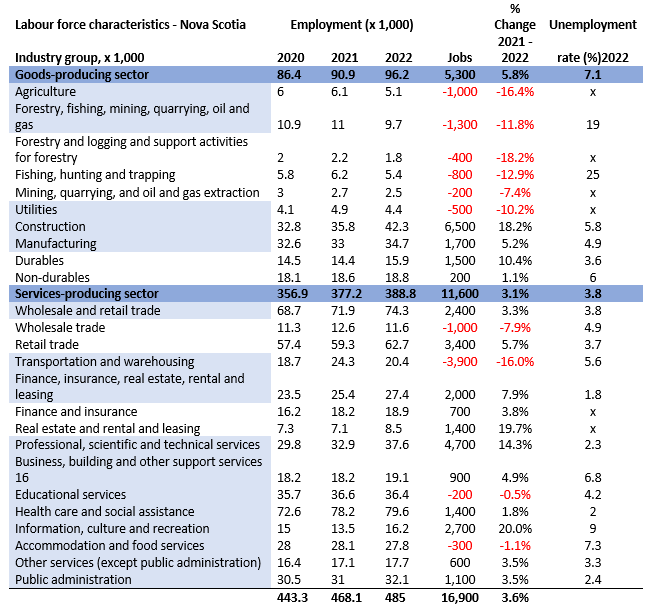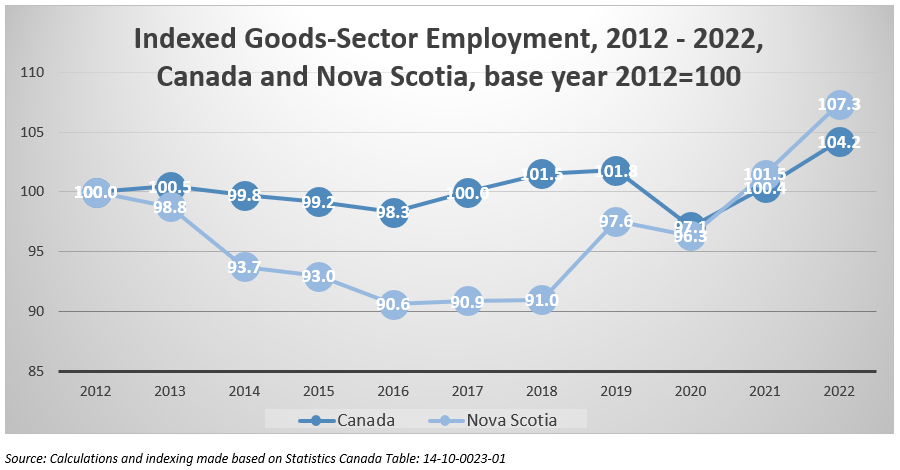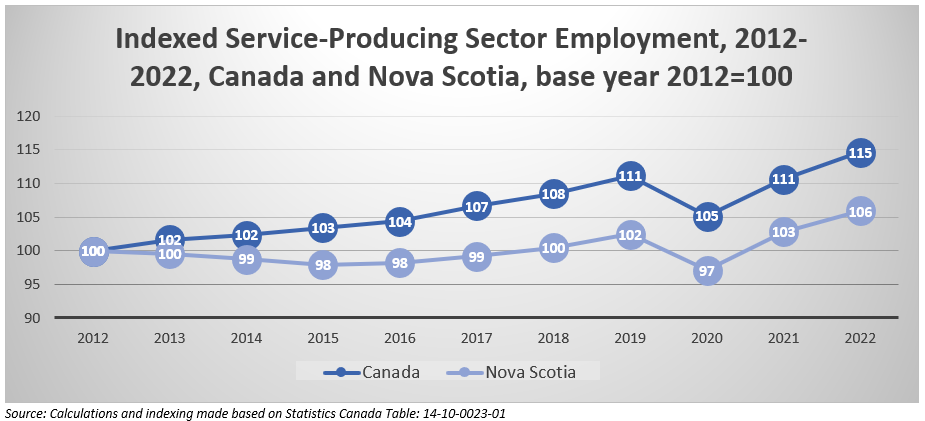Employment and Jobs 2022
Compared to 2021 the province had an overall increase in employment of 3.6% or 16,900 jobs in 2022. Full-time jobs rose by 5.5% (21,300). However, part-time jobs went down for -5% (-4,500).
- The service sector gained 21,300 jobs (3.6%) by adding 16,200 (5.5%) full-time jobs and on the other hand, by losing 4,700 (-6%) part-time jobs.
- The goods producing sector gained 5,300 jobs (5.8%) by adding 5,100 (6%) full-time jobs and 200 (3.3%) jobs in part-time sector.
Nova Scotia’s service-producing sector accounted for 80.2% of provincial employment in 2022. Professional, scientific and technical services accounted for the biggest net job gains with 4,700 new jobs (+14.3%). Information, culture and recreation come in second with 2,700 added jobs (20%). The biggest net loses occurred in transportation and warehousing with a net loss of 3,900 jobs (-16%).
Nova Scotia’s goods-producing sector accounted for 19.8% of provincial employment in 2022. Construction industry led with 6,500 jobs (+18.2%), followed by manufacturing that had net increase of 1,700 jobs (+5.2%). The biggest net loses were in forestry, fishing, mining, quarrying, oil and gas with 1,300 lost jobs (-11.8%). This was followed by agriculture with a net loss of 1,000 jobs (-16.4%).
Unemployment 2022
Historically, unemployment has been higher in the goods-producing sector than in the services-producing sector even though the gap has narrowed in recent years.
- In 2022 unemployment in the goods-producing sector was 7.1% (down from 8.3% in 2021) - a record low dating back to the establishment of the modern Labour Force Survey in 1976.
- Unemployment in the services-producing sector stood at 3.8% (down from 4.6% in 2021).

Data in the graphs below is indexed to the year 2012 to show trends and to compare with the Canadian economy.
Goods-Producing Sector Trends
- From 2012 to 2017, a widening gap appeared in employment growth in the goods-producing sector between Nova Scotia and Canada.
- From 2013 to 2017 the growth in goods-sector employment was essentially flat in Canada but dropped by a total of 8% in Nova Scotia. The resulting gap narrowed between 2017 and 2020, before being nearly eliminated in 2021.
- In 2020, employment in the goods-producing sector contracted by only 1.3% in Nova Scotia versus a 4.7% drop nationally.
- In 2021, employment in the sector grew by 5.2% in Nova Scotia, while the national increase was 3.3%.
- Following 2021, in 2022 employment in goods-producing sector grew by 5.8% in Nova Scotia and 3.8% in Canada.

Service-Producing Sector Trends
Employment in the services-producing sector expanded in Canada throughout the 2012 to 2019 period, with a dip in 2020. In Nova Scotia, the sector struggled from 2012 to 2015, as the employment level dropped by 2.9% in those years before rebounding from 2016 to 2019.
The impact of COVID-19 in 2020 led to decreases in employment in this sector both in Nova Scotia (-5.4%) and Canada (-5.2%). In 2021, employment recovered in the service-producing sector, increasing by 5.7% in Nova Scotia and 5.4% nationally. Compared to 2021, in 2022 employment in the service-producing sector grew 3.9% in Canada and 3.1% in Nova Scotia.
Employment in the service-producing sector in 2022 is 15.0% higher than 2012 levels nationally, and 6.0% higher in Nova Scotia.
